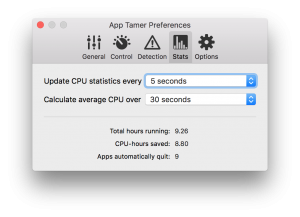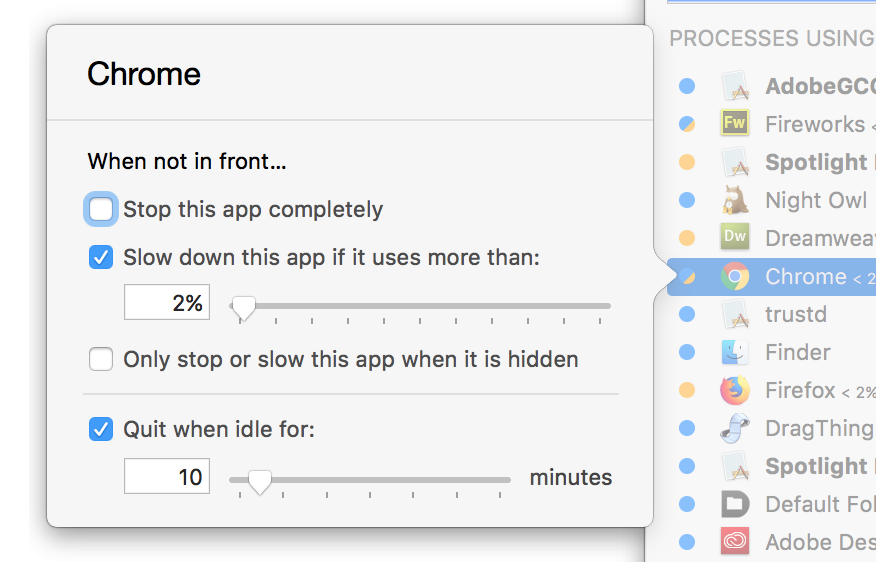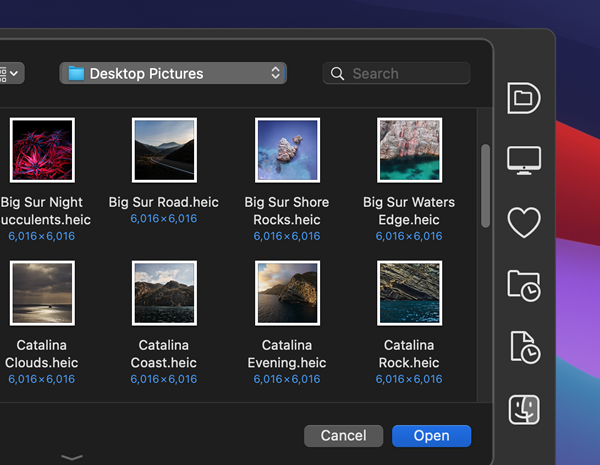
|
|
|
|
|

|
Archive for the ‘High Sierra’ Category
Tuesday, July 5th, 2022
Version 2.7.3 of App Tamer is now available, fixing a couple of problems.
First, my apologies to folks using versions of macOS older than Big Sur: Changes in the last App Tamer update tightened up the spacing of its menu bar icon to comply with modifications Apple made to Monterey and Big Sur. Unfortunately, it also did that on pre-Big Sur systems, often making its icon too close to adjacent ones in the menu bar. I’ve fixed that in 2.7.3.
Second, internal changes that Apple made in macOS resulted in App Tamer reporting the CPU usage of one particular process – kernel_task – incorrectly. App Tamer would show either zero or astronomical values for kernel_task’s processor use, neither of which was correct. In App Tamer’s defense, the system’s approved public API was supplying those numbers and it dutifully reported them without prejudice. Some hunting around in the macOS source code (thank you Apple for making darwin Open Source!) revealed an alternate method that correctly reports the CPU usage of all processes, including kernel_task. So that fix is now available in App Tamer, making it a reliable source of CPU information for all processes again.
As usual, release notes and download links are on the App Tamer release page, or if you’re already using App Tamer, just choose “Check for Update” from its menu. This update is free if you’ve already purchased an App Tamer 2.x license.
Posted in App Tamer, Big Sur, Catalina, El Capitan, High Sierra, Mojave, Monterey, Sierra, Ventura, Yosemite | No Comments »
Tuesday, October 16th, 2018
Jettison 1.7.1 is available, bringing fixes for a couple of simple problems and one complicated one.
Simple stuff:
The previous release of Jettison didn’t correctly show that it was licensed when you looked in the About box after importing a Mac App Store license. This was understandably very confusing to those of you that followed the instructions for upgrading in the FAQ. It now correctly shows “Licensed to: Mac App Store User” (since Apple doesn’t provide a way for us to get your name or Apple ID from your license) and removes the “License” item from its menu.
Also, there were occasions when all of the items in Jettison’s menu would become grayed out. This turned out to be caused by its error window getting stuck behind an application that was in Full Screen mode. It was patiently waiting for you to respond to an error message you couldn’t see – definitely not very helpful. That’s been fixed now.
Messy issues with Power Nap and Wake for Network Access:
When Power Nap or Wake for Network Access are turned on in your Energy Saver prefs, macOS may wake from sleep in ‘dark mode’ – which means it wakes from sleep, but never turns on the display. When this happens, it doesn’t let most applications – including Jettison – know when it wakes up or goes back to sleep. That means that Jettison can’t mount or eject your disks as it’s supposed to.
This would all be well and good if this temporary wakeful state mounted your disks, did its thing (like a Time Machine backup), ejected the disks and then went back to sleep. Unfortunately, while it seems to (mostly) work with Time Machine disks, if other drives get mounted during dark wake, you’ll often see a “Disk not ejected properly” error for them when you return. macOS can’t always manage the mounting and ejecting of disks correctly, even when it’s all by itself in a dark room.
Jettison 1.7.1 solves this problem by refusing to let macOS mount any non-Time Machine drives during a dark wake. This should take care of the disk errors (and associated possibility of data corruption) while still allowing you to use Power Nap and Wake for Network.
On the outside chance that you’re actually getting error messages for your Time Machine drive too, you can launch Terminal and run this command:
defaults write com.stclairsoft.Jettison disableTimeMachinePowerNap 1
That will tell Jettison to prevent your Time Machine drive from being mounted during dark wakes – with the obvious consequence that Time Machine can’t run Power Nap backups while your machine is sleeping. It’s a compromise, but at least it’ll ensure that your backups don’t get corrupted.
You can see the full change history and download Jettison 1.7.1 from the Jettison release page.
Posted in High Sierra, Jettison, Mojave, Sierra, Tips | No Comments »
Thursday, April 19th, 2018
If you’ve used the Recent Files menu to attach files to email messages in Mail.app, you may have noticed a big problem afterwards. Default Folder X would start ignoring requests to switch to other folders – no matter what you selected from the Favorites or Recent Folders menus, the file dialog wouldn’t go where you asked it to.
Version 5.2.4 fixes this bug – my apologies for letting the problem sneak through the testing process in the first place. Despite having a group of testers hammering on version 5.2.3 for several weeks, this one slipped by because I actually added the bug in the process of fixing another one fairly late in the testing period. Oops 🙁
Anyway, choose “Check for Updates” in your current copy of Default Folder X to have it download the new version, or hop over to the Default Folder X release page for details and download links.
Posted in Default Folder X, High Sierra | 3 Comments »
Monday, April 16th, 2018
 Version 5.2.3 of Default Folder X is available. After many requests from users and a bunch of back and forth with Mudi at BinaryNights, the developer of ForkLift, I’m happy to announce that we’ve got Default Folder X and ForkLift working together! Version 5.2.3 of Default Folder X is available. After many requests from users and a bunch of back and forth with Mudi at BinaryNights, the developer of ForkLift, I’m happy to announce that we’ve got Default Folder X and ForkLift working together!
Default Folder X’s “Finder-click” feature now supports ForkLift (version 3.2.2 or higher). If you’ve got a ForkLift window open on your Desktop, clicking on it while a file dialog is frontmost will switch the file dialog so it shows the contents of the folder in the ForkLift window. And if you want to switch to one of the folders open in another tab of that ForkLift window, Control-click on the window to get a menu of folders in other tabs. Also, if you select a folder or file from Default Folder X’s menu in your menubar when a file dialog isn’t frontmost, that file or folder will be opened in ForkLift if it’s running.
If you haven’t tried ForkLift yet, hop over to BinaryNights‘ website and download a copy. It’s a great alternative to the Finder, as well as for viewing and manipulating remote files on FTP, WebDAV, Amazon S3, Google Drive and other servers.
Now back to the changes in Default Folder X 5.2.3…
An enhancement that you probably won’t notice but that makes a big day-to-day difference is a revamping of the code that switches from one folder to another in Open and Save dialogs. I sat down and reconsidered the underlying mechanism, and as a result made it faster, more efficient and more reliable. This also eliminated compatibility issues with Magnet and BetterTouchTool, so it’s a win all around.
There are also bug fixes based on crash logs that have been submitted (yes, I do look at them!) and tech support emails that folks have sent. I got rid of some ugliness in the Folders tab of Default Folder X’s preference window, added AppleScript commands to access recent Finder windows, and enhanced a number of features in little ways.
The official change log is on the Default Folder X release page, along with links to download version 5.2.3.
Posted in Default Folder X, High Sierra | 5 Comments »
Friday, March 16th, 2018
Jettison 1.6
 Before starting a reorganization and rewrite of Jettison’s internals, I figured I’d better officially release the myriad little changes that I’ve been trickling out to various folks as they’ve contacted me with issues. Before starting a reorganization and rewrite of Jettison’s internals, I figured I’d better officially release the myriad little changes that I’ve been trickling out to various folks as they’ve contacted me with issues.
Version 1.6 brings Jettison up-to-date with APFS (the new file system format released in High Sierra) as well as making its drive mounting / remounting procedure more robust. There are also a bunch of bug fixes and improvements in error checking and error reporting, and new AppleScript commands for ejecting, remounting and sleeping.
You can grab the update from the Jettison Release Page, as well as seeing a more complete list of changes there.
Known Issues
There are still a few issues with Jettison on High Sierra, primarily due to some flakiness on High Sierra’s part that I haven’t been able to pin down. If Jettison can’t eject a drive and tells you “try ejecting it in the Finder,” that means that macOS refused to eject the drive, won’t tell Jettison why, and there aren’t any files open on the volume that should logically keep it from being ejected. In that case, Jettison just throws up its hands and says “I give up!”
If you ask the bus driver to stop the bus and he just keeps on driving, what can you do? (Well, you could open the window and jump out of the speeding bus, but I doubt you want me to do that with your external drives…)
So I’m continuing to chase down that issue, as well as a rare one where the machine continually cycles between sleep and wake states every few seconds, resulting in hundreds of “External disks ejected” notifications from Jettison while the machine was supposed to be sleeping. This situation is rare and I’ve been unable to reproduce it here, making it a tough one to figure out. If it’s happening to you, please let me know at support@stclairsoft.com.
Posted in APFS, High Sierra, Jettison | 4 Comments »
Friday, March 2nd, 2018
 Version 2.3.5 of App Tamer is available, bringing several improvements and fixes on the performance side, as well as showing you how much CPU time it has saved. Version 2.3.5 of App Tamer is available, bringing several improvements and fixes on the performance side, as well as showing you how much CPU time it has saved.
It gives a cumulative “CPU-hours saved,” where a CPU-hour is the amount of computing a single processor core can do in an hour when running at 100%. So if it says it’s saved 8.8 CPU-hours, as shown in the image on the right, that means one CPU would have been running full tilt for an additional 8.8 hours if I hadn’t been using App Tamer. Which means the fans in my MacBook Pro would have driven me crazy today without App Tamer 🙂
Other changes include fixing a memory leak that would cause App Tamer to gradually use more and more RAM if left running for long periods of time, fixing some UI glitches and improving VoiceOver support.
Grab a copy of App Tamer 2.3.5 from the App Tamer Release page, or by selecting “Check for Updates” from its menu if you’re already running it.
Posted in App Tamer, High Sierra | No Comments »
Friday, February 16th, 2018
 I’m happy to announce that version 5.2.2 of Default Folder X is available. It fixes several issues, including a bug that could cause Default Folder X to leave Save dialogs stuck on screen indefinitely. Compatibility issues with Keyboard Maestro, LaunchBar and InDesign have also been addressed, and there are a few new AppleScript verbs available for those of you that are using Default Folder X as part of a larger automated workflow. I’m happy to announce that version 5.2.2 of Default Folder X is available. It fixes several issues, including a bug that could cause Default Folder X to leave Save dialogs stuck on screen indefinitely. Compatibility issues with Keyboard Maestro, LaunchBar and InDesign have also been addressed, and there are a few new AppleScript verbs available for those of you that are using Default Folder X as part of a larger automated workflow.
What I’m most pleased with, however, is managing to significantly cut Default Folder X’s “reaction time” – the time it takes from a file dialog appearing until Default Folder X’s controls pop up next to it. It’s been reduced by more than half through intelligent caching and streamlining of the dialog detection code. Default Folder X is faster in other operations too, but that initial delay was the most annoying thing, especially because it had actually gotten slower in High Sierra.
Another thing that’ll interest users of ForkLift and other third-party Finder replacements: Default Folder X now pays attention to the NSFileViewer setting on your system. If you set it to the bundle identifier of your alternate-Finder-app, Default Folder X will use that app to open files and folders, rather than using the Finder. To set this up for ForkLift, for example, open Terminal and enter this command:
defaults write -g NSFileViewer -string com.binarynights.ForkLift-3
To switch back to using the Finder, use:
defaults delete -g NSFileViewer
To use something besides ForkLift, substitute the app’s bundle identifier for “com.binarynights.ForkLift-3” in the command above. Please be aware that this may cause other applications to also use that app as the default file viewer / manager, so your mileage may vary depending on how you want things to work.
And in other ForkLift news, I’m working with Mudi over at Binary Nights to integrate Default Folder X and ForkLift more closely. Default Folder X’s Finder-click feature will work with ForkLift in the near future.
Anyway, enough rambling – go get Default Folder X 5.2.2! If you’re already running Default Folder X, just select “Check for Updates…” from its menu in your menubar. If not, go to https://www.stclairsoft.com/DefaultFolderX/index.html and hit the “Download” button. Oh, and if you want to see the full list of changes, check the Default Folder X Release page.
Posted in Default Folder X, High Sierra | 2 Comments »
Wednesday, January 10th, 2018
 Version 2.3.4 of App Tamer is now available, adding an extra checkbox to the settings for each application. You can now have App Tamer automatically quit an app after it’s been unused for a certain amount of time – handy for those one-shot utilities like password managers, image converters, Contacts, etc that you look at quickly and then accidentally leave open. Version 2.3.4 of App Tamer is now available, adding an extra checkbox to the settings for each application. You can now have App Tamer automatically quit an app after it’s been unused for a certain amount of time – handy for those one-shot utilities like password managers, image converters, Contacts, etc that you look at quickly and then accidentally leave open.
This version also improves App Tamer’s ability to control the CPU usage of applications that employ helper processes to do some of their work. This includes web browsers, Spotlight, virus scanners and backup utilities, among other apps. While App Tamer’s management of CPU usage is always going to be approximate (because it doesn’t know the inner workings of every app), it now keeps an app’s average usage much closer to the limit you’ve specified.
Head over to the App Tamer release page to see the full list of changes and to download a copy of version 2.3.4!
Posted in App Tamer, High Sierra, Sierra | No Comments »
Monday, January 8th, 2018
Default Folder X 5.2.1 is available now. It provides a single fix which corrects problems that Default Folder X 5.2 had when setting Spotlight tags and Finder comments specified in a Save As dialog.
The Details: I got a little overzealous with memory cleanup, which resulted in the tag- and comment-setting tasks deleting themselves as soon as they were created. They never got a chance to actually do their jobs – how unfair!
My apologies for the back-to-back updates, and not catching this before release. “Hey, why isn’t this reference marked as ‘weak’ inside this block? I’ll just fix that before I finalize the build – it’s an obvious goof, and what could go wrong?” Right, Jon.
Posted in Default Folder X, High Sierra | No Comments »
Wednesday, January 3rd, 2018
 Version 5.2 of Default Folder X is now available here. By popular demand, I’m bucking the Apple monochrome-file-dialog theme and letting you choose color toolbar icons if you want ’em. While that’s not a big deal to some people, it makes clicking on the correct icon easier for many folks. It also just adds a little more color to brighten your day 🙂 Version 5.2 of Default Folder X is now available here. By popular demand, I’m bucking the Apple monochrome-file-dialog theme and letting you choose color toolbar icons if you want ’em. While that’s not a big deal to some people, it makes clicking on the correct icon easier for many folks. It also just adds a little more color to brighten your day 🙂
Default Folder X 5.2 is also back in step with Apple’s iCloud Drive ruse. Even though your Desktop and Documents folders aren’t really in your iCloud Drive folder, Default Folder X will pretend they are by showing them there in its menus. And yes, it understands what to do if you turn “Desktop and Documents” off in your iCloud settings, which then actually does put them in your iCloud Drive folder, along with separate Desktop and Documents folders in your Home folder (no, that’s not confusing).
And if you’re running High Sierra, you may have noticed that Default Folder X stopped showing any iCloud items in its Recent Files and Recent Folders menus recently. That’s because Apple has once again hidden your Library folder, and iCloud stuff is actually stashed inside it. Prior to version 5.2, Default Folder X wouldn’t show items in hidden folders because, well, you might not want everyone to see all your hidden stuff, right? Well, now ~/Library/Mobile Documents/ (aka iCloud) is treated specially so that Default Folder X is once again useful in getting to your recently used files and folders, even when they’re on iCloud.
There are also user-experience improvements in 5.2, namely the process of authorizing Default Folder X in the Security & Privacy settings in System Preferences, and the way Default Folder X handles Gatekeeper Path Randomization if you download and launch it in place. And as a bonus, your license information will no longer be randomly forgotten when a bug in macOS stops giving Default Folder X information from its own preference file. My apologies to anyone that’s gotten bitten by that in the past.
Finally, updating will also net you a more capable Compress command, a handful of fixes for bugs, memory leaks and such, and some prettier icons in Default Folder X’s menus. If you’re already running Default Folder X, just choose “Check for Updates” from its menu – or run over to the Default Folder X release page to download a copy to install manually.
Posted in Default Folder X, High Sierra | 2 Comments »
|

|
|

|
|





 Version 2.3.4 of App Tamer is
Version 2.3.4 of App Tamer is  Version 5.2 of Default Folder X is now available
Version 5.2 of Default Folder X is now available